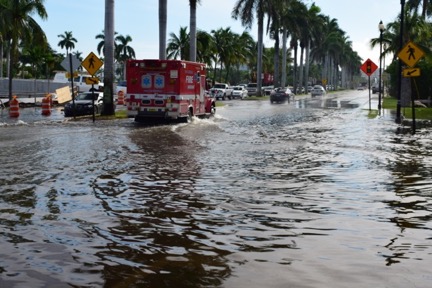Flooding hazard due to sea level rise (SLR) is a global problem. It affects about 10% of the Earth's population, roughly 700 million people, who live in low-lying coastal areas. In the US alone, 5.7 million people are living on land within 4 feet of high tide and are in high risk of coastal flooding. Despite the global SLR problem, coastal flooding hazard is a local problem, due to local elevation and elevation change (subsidence) of coastal communities, regional variations in the rate of SLR, as well as possible exposure to storm surge induced by extreme weather events.
The Florida coast is one of the most vulnerable areas to Sea Level Rise (SLR) due to its low elevation, large population concentrations, and economic vulnerability. A large portion of the state's population (2.2. million people) lives in low-lying coastal areas prone to coastal flooding (below 4 feet). The state is also highly vulnerable to sea level rise in terms of infrastructure and residential property exposure to coastal flooding.
In our initial study, we focus on the increasing flooding hazard in Miami Beach, which has caused severe property damage and significant disruptions to daily life. We evaluated the flooding frequency and its causes by analyzing tide and rain gauges, media report, insurance claim, and photo records from Miami Beach acquired during 1998-2013. Our analysis indicated that significant changes in flooding frequency occurred after 2006, in which rain-induced events increased by 33% and tide-induced events increased by more than 400%. We also analyzed tide gauge records from southeast Florida and detected a decadal-scale accelerating rates of SLR. The average pre-2006 rate is 3±2 mm/yr, similar to the global long-term rate of SLR, whereas after 2006 the average rate of SLR in southeast Florida rose to 9±4 mm/yr. Our results suggest that engineering solutions to SLR should rely on a regional SLR rate projections and not only on the commonly used global SLR projections.
We are currentlt assessing the contributions of global, regional, and local processes to the increasing rates of sea level rise along the Florida coast and assess their impact on coastal flooding hazard until the end of the century. Preliminary results indicate that sea level rise along the Florida coast in the past 1-2 decades is significantly faster than the global mean rise for the same time period (7-14 mm/yr vs. 3.3±0.4 mm/yr). The faster rate is induced mainly by a regional ocean dynamic component related to the weakening to ocean circulation in the northern Atlantic. We also detected localized subsidence (1-3 mm/yr) mainly in the western side of Miami Beach, which was built om reclaimed wetlands. The higher rate of sea level rise in Florida will affect low lying coastal communities faster than expected when using global grojections of sea level rise.

Figure 1. (left)"Sunny sky" flooding in Miami Beach. (right) Annual flooding occurrence in Miami Beach between 1998-2013 indicating a significant increase in tide flooding events (green) since 2006.

Figure 2. (a) High tide flooding in Fort Lauderdale, FL, during the 2015 king tide conditions (September 28, 2015).